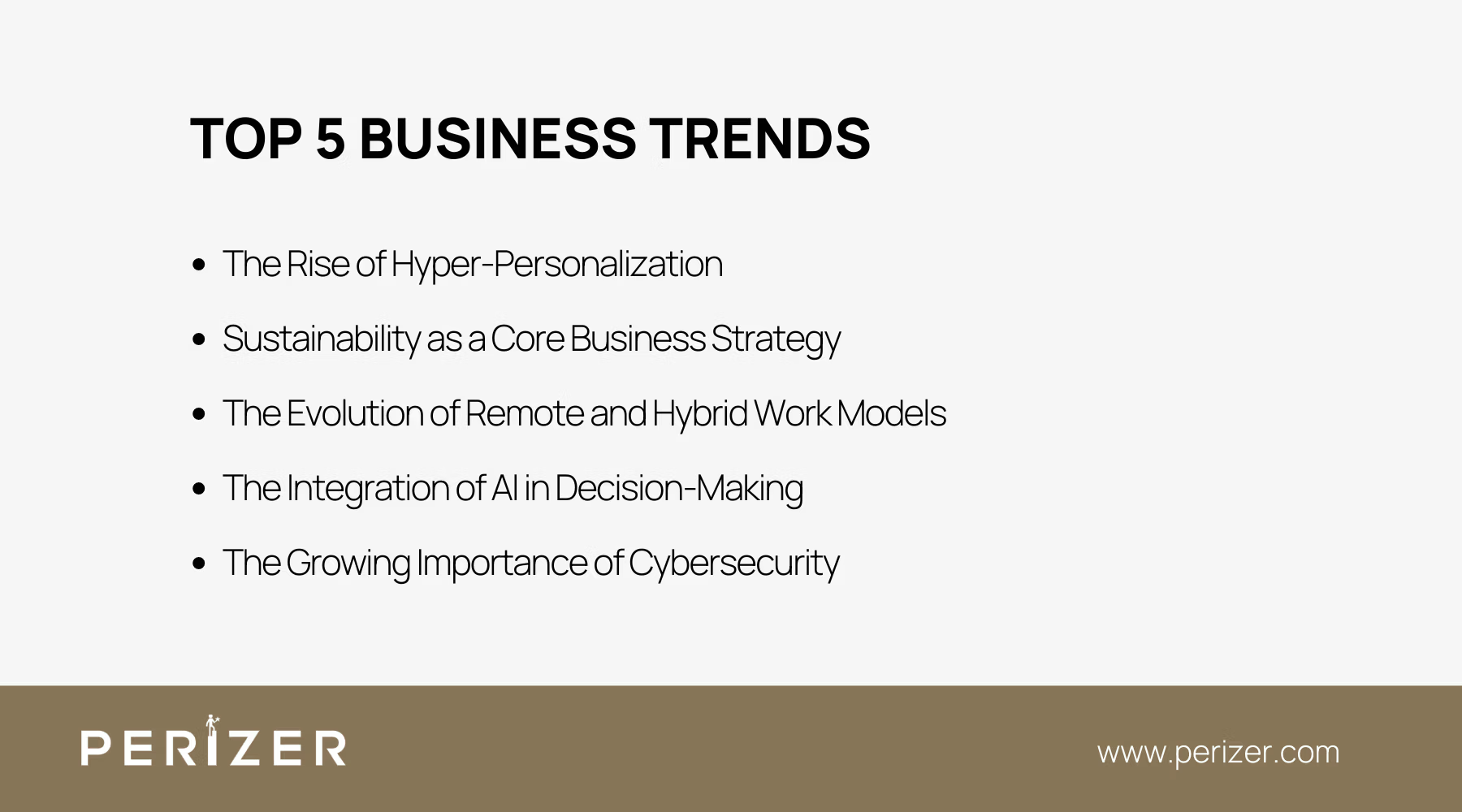Top 5 Future Business Trends to Keep an Eye On
Stay ahead with the top 5 business trends shaping the future. Discover the key shifts driving success this year from AI to sustainable practices

Understanding business trends is important for anyone looking to stay competitive in today’s rapidly evolving environment. As you prepare for the future, it’s more important than ever to monitor the trends that will shape the future of your industry. These trends aren’t just temporary shifts - they’re indicators of deeper changes in how businesses operate, innovate, and grow. By staying informed and adaptable, you can position yourself to not only respond to these changes but to capitalize on them.
In this article, we’ll explore the top business trends to watch in 2024, with a focus on how you can use these developments to drive strategic success and stay ahead of the competition.
What are Business Trends?
Business trends are the directions in which the business world evolves, driven by factors like technological advancements, changing consumer behavior, economic shifts, and new regulations. These trends affect how businesses operate, from adopting new technologies and responding to market changes to adapting to economic conditions and regulatory updates. Understanding these trends is important for staying competitive, as they help businesses identify opportunities, reduce risks, and align with evolving customer expectations. By recognizing and adapting to these trends, businesses can drive growth and ensure long-term success.
Top 5 Business Trends

1. The Rise of Hyper-Personalization
Hyper-personalization is more than just a marketing tactic—it’s a powerful strategy that uses advanced and AI to create highly customized experiences for your customers. In the future, this trend will move beyond simple product recommendations and explore deeply personalized customer journeys.
How Does It Work?
To implement hyper-personalization, you need to go beyond traditional data points like purchase history and demographics. Start by integrating AI-driven tools that analyze customer behavior in real time, allowing you to predict their needs before they even articulate them. For example, by using machine learning algorithms, you can track micro-behaviors, such as the time spent on specific pages or the sequence of interactions with your site. This data enables you to deliver content, offers, and recommendations that feel custom-made for each individual.
How to Do It?
Begin by improving your data collection infrastructure to capture more detailed insights. This includes investing in advanced CRM systems that integrate with AI and machine learning platforms. Also, focus on cross-channel data integration to ensure you have a holistic view of your customer’s interactions with your brand.
Once your data infrastructure is in place, focus on creating dynamic content that adapts in real-time based on the data insights. This might involve developing personalized landing pages, email campaigns, and even individualized product offerings. The key is to ensure that every touchpoint feels unique and relevant to the customer, which in turn drives higher engagement and loyalty.
2. Sustainability as a Core Business Strategy
Sustainability is no longer a secondary concern—it’s becoming central to business strategies across all industries. In the future, businesses that fail to integrate sustainability into their core operations risk falling behind as both consumers and regulators increasingly demand eco-friendly practices.
How Does It Work?
Incorporating sustainability into your business strategy involves more than just reducing carbon footprints or using eco-friendly materials. It’s about rethinking your entire value chain—from sourcing to production, and even to post-consumer disposal. For example, you could explore circular economy models that design out waste and keep products and materials in use for as long as possible.
How to Do It?
Start by conducting a comprehensive sustainability audit of your current operations. Identify areas where you can reduce waste, improve energy efficiency, and minimize environmental impact. Next, set ambitious, measurable goals for sustainability and ensure that they are aligned with your business objectives. This might include transitioning to renewable energy sources, implementing sustainable packaging solutions, or adopting greener supply chain practices.
Additionally, consider obtaining sustainability certifications, which can enhance your brand’s reputation and appeal to eco-conscious consumers. Communication is also key—make sure your sustainability efforts are transparent and well-documented, both for internal stakeholders and external audiences.
3. The Evolution of Remote and Hybrid Work Models
The pandemic accelerated the adoption of remote work, and in the future, the trend will continue to evolve. However, the focus is shifting from merely enabling remote work to optimizing it for productivity, employee engagement, and organizational culture.
How Does It Work?
To successfully implement and optimize remote and hybrid work models, you need to move beyond the basics of virtual meetings and collaborative tools. The future of work lies in creating a seamless experience where remote and on-site employees are equally engaged and productive. This includes implementing advanced collaboration platforms that integrate with AI to provide insights on productivity, workload balance, and even employee well-being.
How to Do It?
Begin by reassessing your remote work policies to ensure they are aligned with your organizational goals and culture. Consider implementing AI-driven tools that help monitor and improve productivity without being intrusive. For instance, AI can help track project progress, identify obstacles, and suggest adjustments to workflows in real time. It’s also important to invest in training programs that help managers and employees thrive in a hybrid environment. Focus on building a culture of trust and accountability, where employees are empowered to work autonomously yet stay connected to their teams.
Moreover, rethink your office space—consider converting traditional workspaces into collaboration hubs that employees can use when they need to engage in team activities while maintaining the flexibility to work remotely.
4. The Integration of AI in Decision-Making
AI is no longer a visionary concept; it's a vital tool for business leaders looking to make smarter, data-driven decisions. In the future, AI will play an even more significant role in strategic decision-making across all levels of the organization.
How Does It Work?
AI can analyze vast amounts of data at lightning speed, identifying patterns and trends that would be impossible for humans to detect. This allows you to make more informed decisions, whether it’s forecasting market trends, optimizing supply chains, or personalizing customer experiences. AI can also help automate routine decisions, giving your team more time to focus on more strategic tasks.
How to Do It?
To integrate AI into your decision-making process, start by identifying the key areas where AI can provide the most value. This could include predictive analytics for market trends, customer sentiment analysis, or even operational efficiency. Next, invest in AI tools and platforms that are customized to your specific industry needs. Ensure that your data infrastructure is strong and capable of feeding accurate, real-time data into these AI systems.
It’s also important to build a culture of data literacy within your organization, where employees are trained to understand and use AI-driven insights. Finally, maintain a human element in decision-making—use AI as a tool to improve human judgment, not replace it.
5. The Growing Importance of Cybersecurity
As businesses become increasingly digital, the threat landscape is expanding at an alarming rate. In the future, cybersecurity will be at the core of business strategies, with a focus on proactive measures rather than reactive responses.
How Does It Work?
Effective cybersecurity involves more than just firewalls and antivirus software. It requires a comprehensive approach that includes threat intelligence, continuous monitoring, and incident response strategies. Cyber threats are becoming more sophisticated, targeting everything from cloud infrastructures to IoT devices, which means your cybersecurity strategy must evolve to keep pace.
How to Do It?
Start by conducting a thorough risk assessment to identify potential vulnerabilities within your digital infrastructure. This includes everything from employee devices to cloud services and third-party vendors. Once you’ve identified the risks, implement a multi-layered security approach that includes encryption, multi-factor authentication, and regular security audits. Invest in cybersecurity training for your employees, as human error remains one of the biggest security risks.
Additionally, consider deploying AI-driven cybersecurity tools that can detect and respond to threats in real time. Finally, ensure that you have a strong incident response plan in place, so you can quickly reduce any breaches and minimize damage
Conclusion
Staying ahead of key business trends is important for your success. By adopting personalization, sustainability, flexible work, smarter decision-making, and stronger cybersecurity, you’ll be well-prepared to handle the changes on the horizon. These trends are more than just new developments—they're chances to innovate and expand. By incorporating them into your strategy, you position your business to flourish in a challenging market.
FOCUSED, FAST, GOVERNMENT READY
Stay Tuned With Our Latest Insights

Staff Augmentation
Learn how to select the perfect IT outsourcing partner to promote your team’s capabilities, improve productivity, and drRead more...

Staff Augmentation
Find the perfect staff augmentation partner by aligning your goals, evaluating expertise, managing costs, and ensuring aRead more...

Cyber Security
We focus on understanding the needs, behaviors, and expectations of your users through extensive user research. This infRead more...